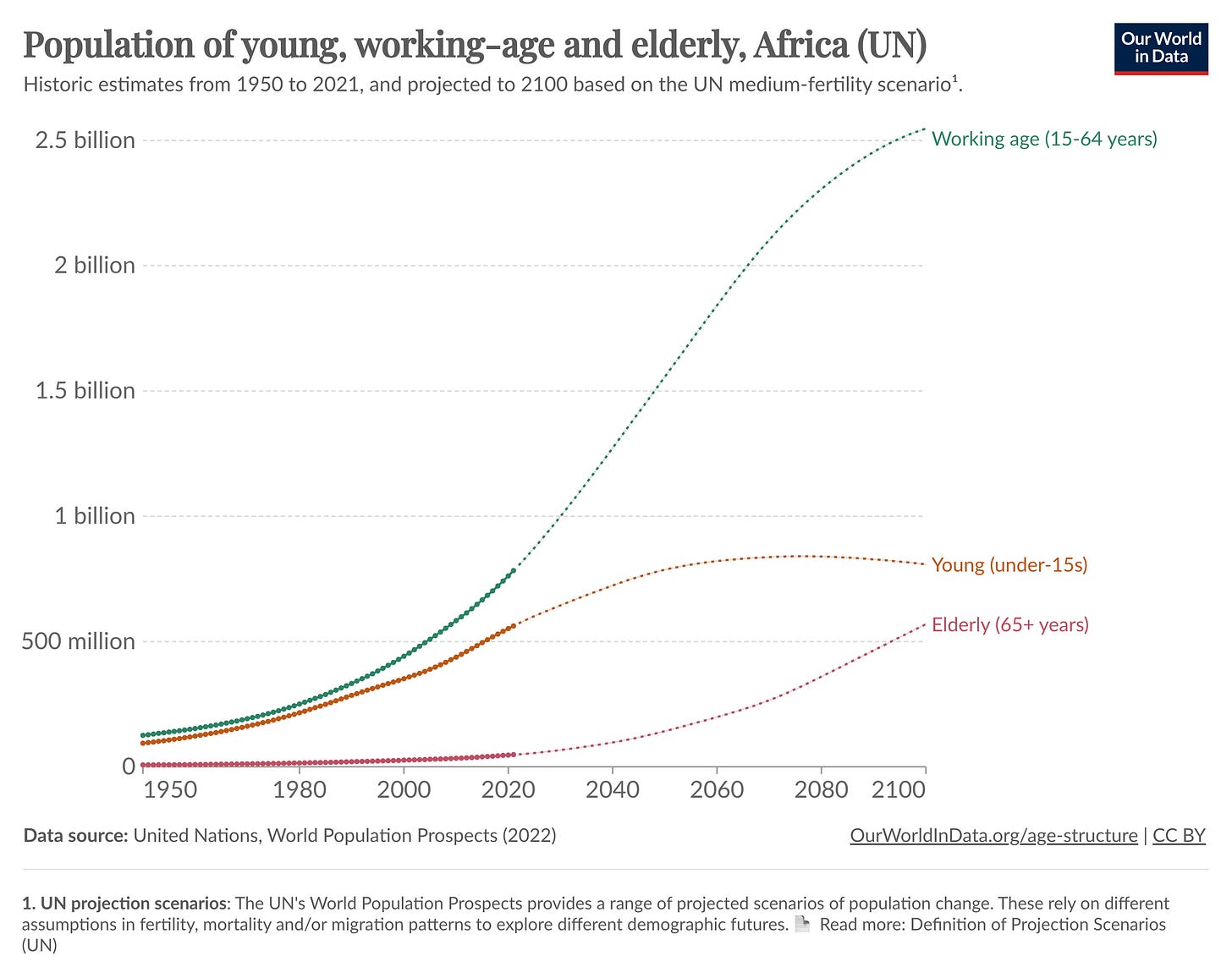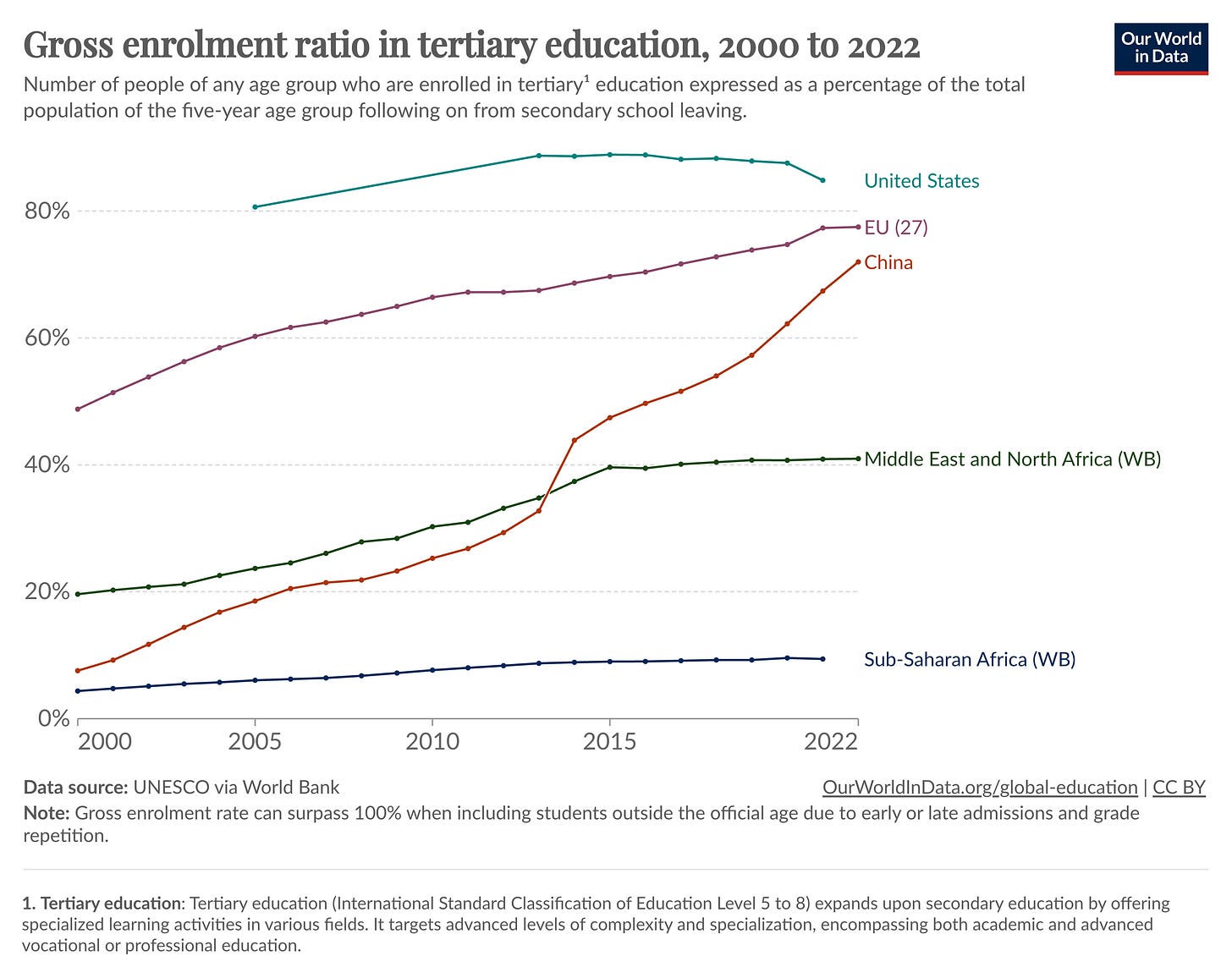Young, Vibrant, and Transformative: Africa's Demographic Advantage
Harnessing the Power of the World's Youngest Continent
Hi everyone,
Happy New Year from the Exseede Team!
Did you know that while many parts of the world face an aging population crisis, about half of Africa’s 1.5 billion people are under 19 years old?
As of 2023, there are 827 million people in the working age on the African continent - and that number keeps increasing. Just imagine, the amount of young, talented individuals who will soon enter the job market, bringing fresh energy and innovative ideas.
This is a major asset for future economic success.
So, today, we’ll take an in-depth look at the demographics, challenges, and the immense potential of Africa’s youthful population and workforce.
Let’s dive in.

🕐 In a Hurry? Here's a 1-Minute Summary:
Youthful Demographic: Africa, with its population of nearly 1.5 billion and a median age of 19, has the world's largest young population. This demographic is set to significantly expand the global working-age population in the next three decades, with Africa contributing 80% of this growth.
Workforce Challenges and Opportunities: Despite its rapid population growth, Africa faces challenges in increasing worker productivity, with a mismatch between education systems and job market needs. However, this also presents opportunities for economic development through innovation and entrepreneurship.
Shift from Manufacturing to Services: Unlike traditional growth models, Africa is witnessing a shift from manufacturing to service sectors. This shift includes a move towards specialized, high-value service tasks in sectors like IT and financial services.
Spotlight: Kenya's Outsourcing Hub Role: Kenya is emerging as a player in global outsourcing, especially in the BPO sector, attracting major global companies and offering a range of services. This development is supported by a skilled workforce and a strong tech ecosystem.
Investor Opportunities in a Young Workforce: Africa's young workforce presents several opportunities for investors, including a large labor pool, adaptability to new skills and technology, long-term workforce sustainability, and a growing consumer market.
⏳ Ready for a Deeper Dive? Here's the Breakdown:
Africa’s Youth: A Demographic Powerhouse
Africa is home to the world's largest young population. With nearly 1.5 billion people and a median age of just 19 years, the continent is poised for a remarkable demographic transformation.
In the next three decades, the global working-age population will grow by 2 billion, with 80% of this growth stemming from Africa.
By 2050, we're looking at working-age population of 1.56 billion people.
The rapid population growth, driven by high fertility rates and declining mortality rates due to improved healthcare and increased access to clean water and sanitation, presents challenges and opportunities.
Challenges: The productivity gap
While the continent's workforce expands rapidly, a corresponding increase in productivity remains elusive.
Across key sectors like services, agriculture, and manufacturing, Africa grapples with productivity challenges.
There’s a mismatch between current education systems and the job market needs.
There's a significant gap in tertiary education in Africa compared to other regions. Digital education is viewed as a solution to bridge this gap and provide high-quality, affordable education at scale.
Yet, the silver lining lies in the untapped potential of this burgeoning workforce.
💡 Spotlight: The productivity puzzle - Services vs. Manufacturing
Africa's path differs from traditional growth models, with a notable shift from manufacturing to services.
A study reveals that, unlike the manufacturing-led growth in countries like Taiwan and Vietnam, nations such as Tanzania and Ethiopia are witnessing a surge in employment within small and informal business sectors.
This is also due to global developments in production technology, which has focused on saving labor.
Many African countries joined the global economy when these technological changes were already happening. This makes it tough for them to compete globally without using similar technologies that don't create many jobs - and can explain the unusual, early shift to the services sector.
Contrary to past views, recent studies highlight the pivotal role of service sectors like IT, financial services, and business services in driving job creation and productivity, akin to manufacturing.
This sector already accounts for nearly 40% of employment across Africa, second only to agriculture.
Potential: Fueling innovation and economic growth
The continent's young population is a source of innovation and entrepreneurial spirit.
With strategic investments in education and technology, this demographic can catalyze significant economic growth.
From fostering growth in labor-intensive industries to contributing to the global workforce through remote work and digital services, the opportunities are boundless.
It also means an expanding consumer market, which makes the continent more attractive for foreign investments.
💡 Spotlight: Kenya’s rise as a global outsourcing hub 🇰🇪🇰🇪
Kenya is rapidly emerging as a key player in global outsourcing, particularly in the Business Process Outsourcing sector. As a recognized ICT hub, the country's strategic focus on BPO in its Vision 2030 and a knowledge-based economy has made it a favored outsourcing destination.
Kenya offers a wide range of outsourcing services, from customer support to software development, fueled by its expanding ICT sector, leading to economic reforms and an enhanced business environment.
The country is attracting major global companies, particularly in fintech, telecom, and customer support, thanks to its skilled workforce and modern tech ecosystem.
Moving beyond basic functions, Kenya's outsourcing sector is now tackling specialized, high-value tasks. This shift, coupled with a motivated workforce and strong education system, positions Kenya and Africa more broadly as attractive outsourcing destinations with potential for significant growth in the global market.
Moving into Action: 7 reasons a young workforce presents a range of opportunities to investors
Large labor pool: A large workforce can be particularly advantageous for labor-intensive industries, where the availability of a large number of workers can lead to more competitive labor costs and increased production capacities. For example in the ready-made garment sector.
Skills and Training: Young populations are generally more adaptable and open to learning new skills. Investors can capitalize on this by providing training and development programs, which can create a skilled labor force tailored to specific industry needs.
Entrepreneurship: Younger workers often bring fresh perspectives and are more inclined towards innovation and entrepreneurship. This can lead to the development of new industries and the revitalization of existing ones, providing fertile ground for investment in start-ups and innovative projects.
Technology: Younger generations are typically more tech-savvy and adaptable to technological changes. This makes them ideal for industries evolving with technological advancements, such as IT, fintech, and digital services.
Sustainability: Investing in regions with a younger population can offer long-term workforce sustainability. As older generations retire, a younger workforce ensures a continuous supply of labor, reducing the risks associated with an aging population.
Productivity: With appropriate training and education initiatives, the productivity of a young workforce can increase significantly over time, contributing to faster economic growth and higher returns on investment.
Consumer market: A young population also signifies a growing consumer market. Young consumers are more likely to adopt new products and services, offering a vast market potential for various consumer goods, technology, and services.
Sources to learn more:
Africa’s manufacturing puzzle: Evidence from Tanzanian and Ethiopian firms - NBER Working paper series
The Demography of the Labor Force in Sub-Saharan Africa: Challenges and Opportunities by GLM LIC
Boosting Labor productivity in sub-Saharan African countries could bring transformational economic benefits to the region by the World Bank
Industrial policy and labor productivity growth in Africa: does the technology choice matter? in Journal of Economic Structures
Labor productivity growth and industrialization in Africa in Journal of Economic Perspectives
Enjoying out content?
Don’t keep it for yourself and share!
Subscribe to not miss future updates!
Feedback or thoughts?
Please let us know! Just reply to this e-mail. We’re happy to hear from you!
Thanks for reading,
Carolin
Disclaimer: All information provided is not intended to serve as investment advice. Any mention of industries or countries should not be taken as an endorsement.



